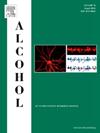伊布司特减轻酒精使用障碍患者疼痛强度与大量饮酒之间的关联:一项随机临床试验的二次分析
IF 2.9
4区 医学
Q3 PHARMACOLOGY & PHARMACY
引用次数: 0
摘要
背景:疼痛经常与酒精使用障碍(AUD)同时发生,并可能影响治疗效果。在一项已完成的随机临床试验的二级分析中,我们检查了基线疼痛强度和疼痛相关残疾是否能缓解布司特(一种神经免疫调节剂)在12周内对饮酒结果的影响。方法:患有中重度AUD的参与者(N = 102, 60%为男性,M年龄= 44.26,SD = 10.81)被随机分配到布替司特组(50mg,每日两次)或安慰剂组,为期12周。疼痛强度和残疾在基线时使用分级慢性疼痛量表进行评估。分段线性混合效应模型测试了疼痛对重度饮酒天数百分比(PHDD)、戒酒天数百分比、每天饮酒量和每天饮酒量的调节作用,并对试验早期(基线-第2周)和后期(第4-12周)进行了调整。结果:疼痛变量与任何基线饮酒结局均无显著相关(所有|r|≤0.08,p >.45)。PHDD在早期和晚期均出现了显著的三方相互作用(药物×疼痛强度×时间)(ps < 0.05),表明疼痛强度越高,安慰剂组的PHDD越严重(b = 0.10, p = 0.04),而布司特组则不然(b = 0.007, p≥0.89)。类似的相互作用观察到疼痛强度和疼痛相关的残疾每天饮酒,虽然简单的斜坡不显著。对于戒酒天数百分比或每个饮酒日的饮酒量,没有发现显著的调节作用。结论:伊布司特减弱了基线疼痛强度与大量饮酒之间的正相关,表明疼痛强度可能确定AUD亚组更有可能从神经免疫靶向药物治疗中获益。这些发现支持将疼痛表型纳入AUD治疗研究,并指出了一种精确医学方法来提高治疗效果。本文章由计算机程序翻译,如有差异,请以英文原文为准。
Ibudilast attenuates the association between pain intensity and heavy drinking in alcohol use disorder: A secondary analysis of a randomized clinical trial
Background
Pain frequently co-occurs with alcohol use disorder (AUD) and may influence treatment response. In this secondary analysis of a completed randomized clinical trial, we examined whether baseline pain intensity and pain-related disability moderate the effects of ibudilast, a neuroimmune-modulating agent, on drinking outcomes over 12 weeks.
Method
Participants (N = 102; 60 % male; M age = 44.26, SD = 10.81) with moderate-to-severe AUD were randomized to ibudilast (50 mg twice daily) or placebo for 12 weeks. Pain intensity and disability were assessed at baseline using the Graded Chronic Pain Scale. Piecewise linear mixed-effects models tested the moderating effect of pain on percent heavy drinking days (PHDD), percent days abstinent, drinks per day, and drinks per drinking day, adjusting for early (baseline–Week 2) and late (Weeks 4–12) trial phases.
Results
Pain variables were not significantly correlated with any drinking outcome at baseline (all |r| ≤ .08, p > .45). Significant three-way interactions (Medication × Pain Intensity × Time) emerged for PHDD in both early and late phases (ps < 0.05), indicating that higher pain intensity predicted greater PHDD in the placebo arm (b = 0.10, p = .04) but not in the ibudilast arm (b = 0.007, p ≥ .89). Similar interactions were observed for pain intensity and pain-related disability on drinks per day, though simple slopes were nonsignificant. No significant moderation effects were found for percent days abstinent or drinks per drinking day.
Conclusions
Ibudilast attenuated the positive association between baseline pain intensity and heavy drinking, suggesting that pain intensity may identify an AUD subgroup more likely to benefit from neuroimmune-targeted pharmacotherapy. These findings support incorporating pain phenotyping into AUD treatment research and point toward a precision medicine approach to enhance treatment efficacy.
求助全文
通过发布文献求助,成功后即可免费获取论文全文。
去求助
来源期刊

Alcohol
医学-毒理学
CiteScore
4.60
自引率
4.30%
发文量
74
审稿时长
15.6 weeks
期刊介绍:
Alcohol is an international, peer-reviewed journal that is devoted to publishing multi-disciplinary biomedical research on all aspects of the actions or effects of alcohol on the nervous system or on other organ systems. Emphasis is given to studies into the causes and consequences of alcohol abuse and alcoholism, and biomedical aspects of diagnosis, etiology, treatment or prevention of alcohol-related health effects.
Intended for both research scientists and practicing clinicians, the journal publishes original research on the neurobiological, neurobehavioral, and pathophysiological processes associated with alcohol drinking, alcohol abuse, alcohol-seeking behavior, tolerance, dependence, withdrawal, protracted abstinence, and relapse. In addition, the journal reports studies on the effects alcohol on brain mechanisms of neuroplasticity over the life span, biological factors associated with adolescent alcohol abuse, pharmacotherapeutic strategies in the treatment of alcoholism, biological and biochemical markers of alcohol abuse and alcoholism, pathological effects of uncontrolled drinking, biomedical and molecular factors in the effects on liver, immune system, and other organ systems, and biomedical aspects of fetal alcohol spectrum disorder including mechanisms of damage, diagnosis and early detection, treatment, and prevention. Articles are published from all levels of biomedical inquiry, including the following: molecular and cellular studies of alcohol''s actions in vitro and in vivo; animal model studies of genetic, pharmacological, behavioral, developmental or pathophysiological aspects of alcohol; human studies of genetic, behavioral, cognitive, neuroimaging, or pathological aspects of alcohol drinking; clinical studies of diagnosis (including dual diagnosis), treatment, prevention, and epidemiology. The journal will publish 9 issues per year; the accepted abbreviation for Alcohol for bibliographic citation is Alcohol.
 求助内容:
求助内容: 应助结果提醒方式:
应助结果提醒方式:


